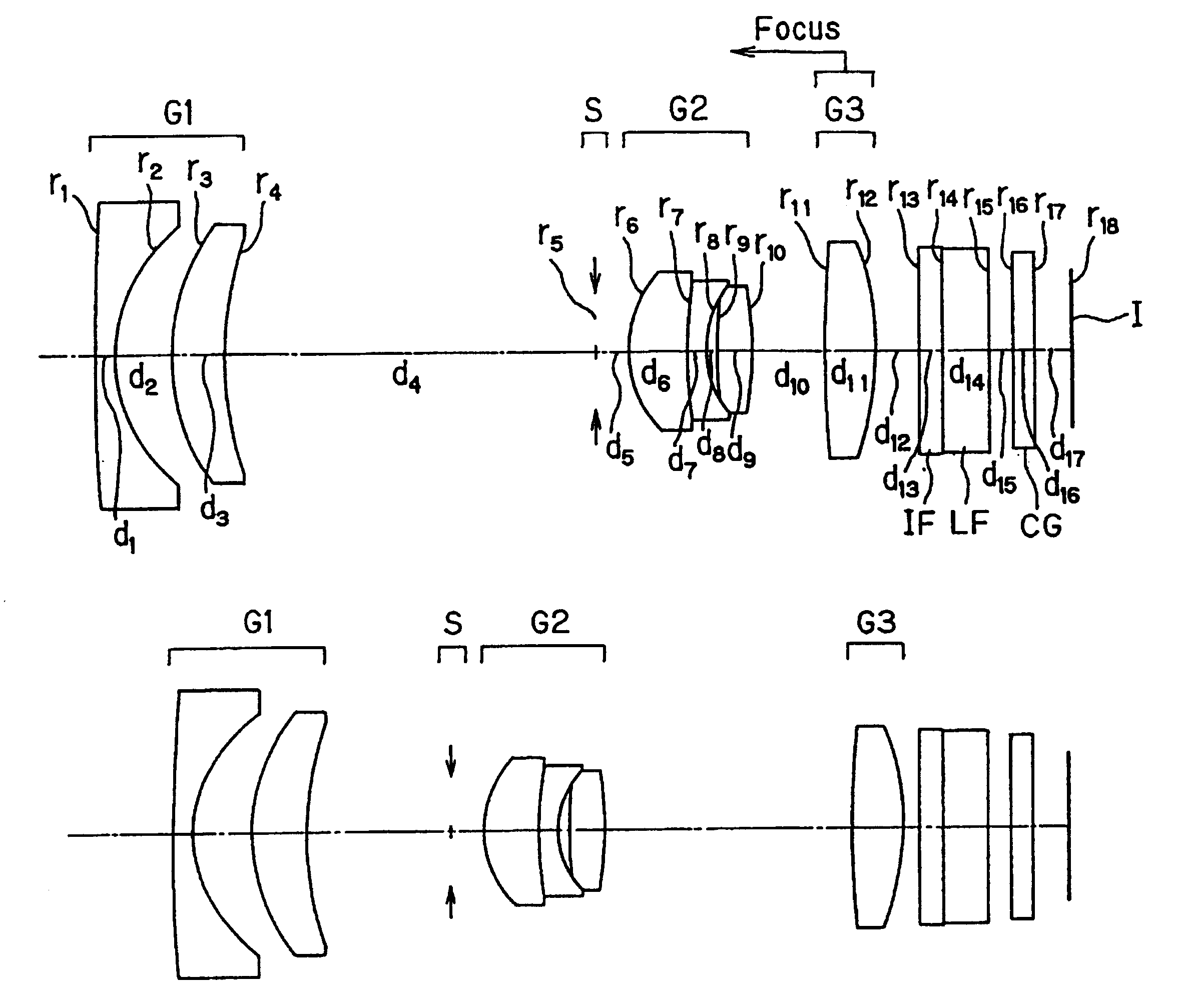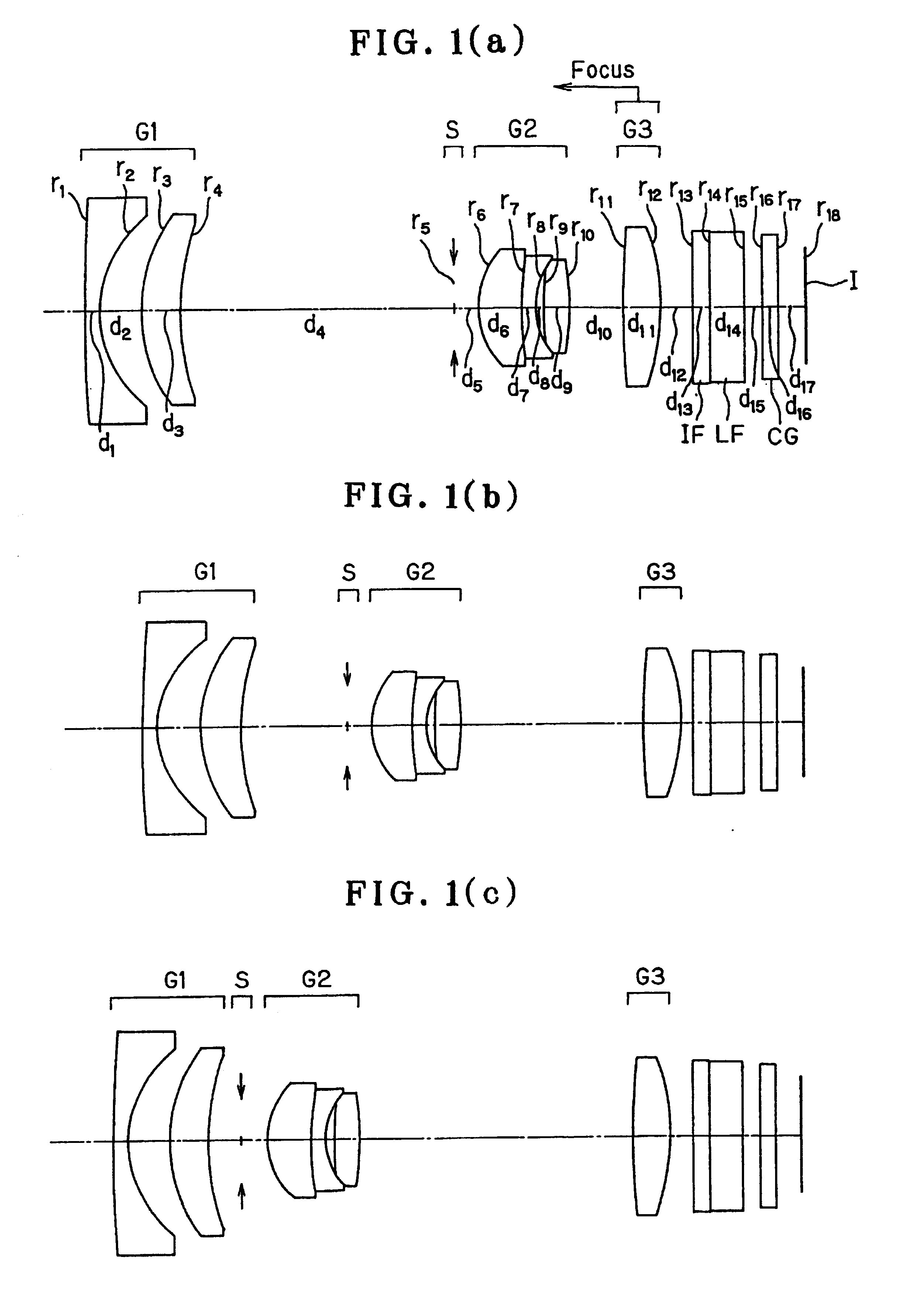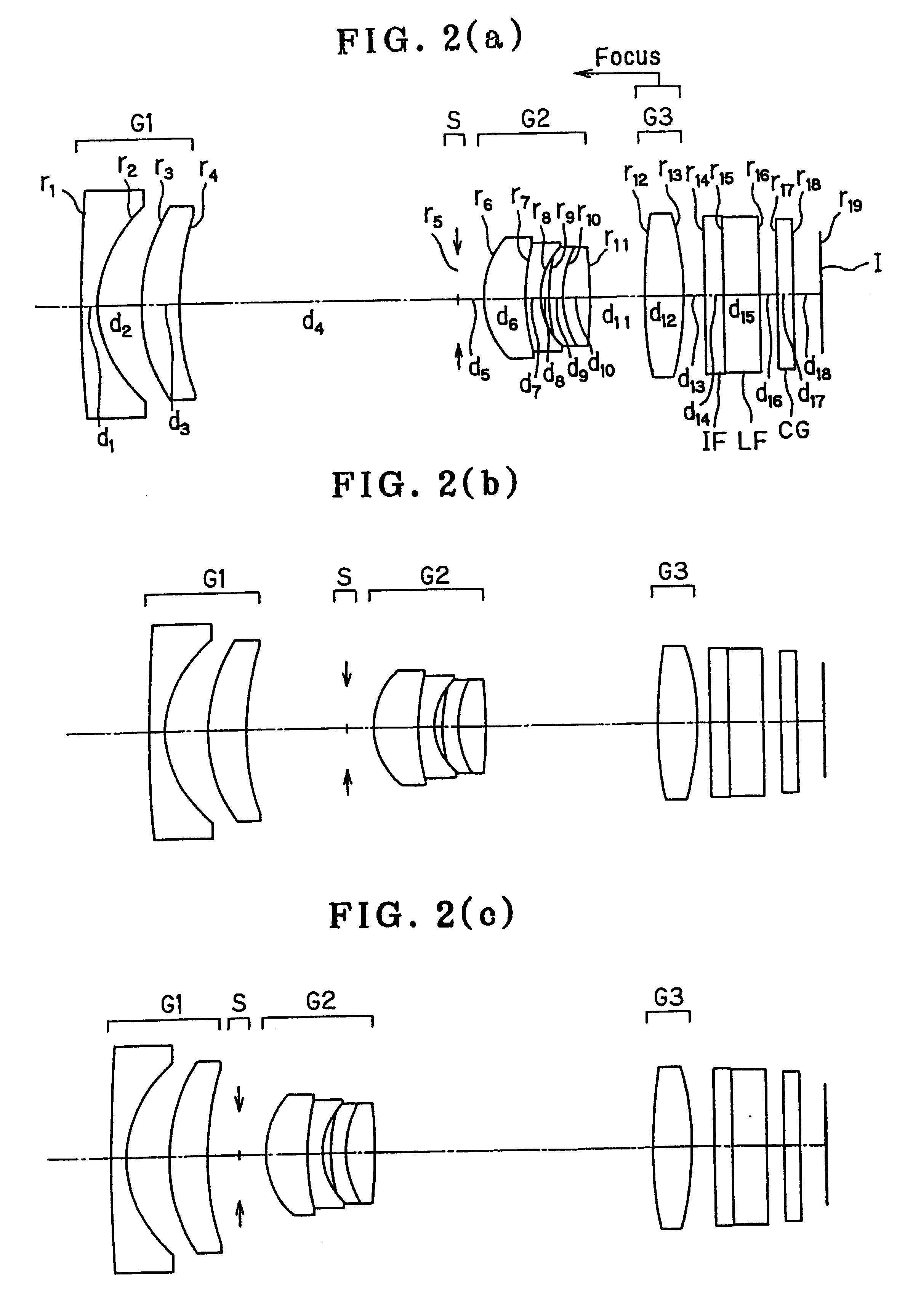Zoom lens, and electronic imaging system using the same
a technology of electronic imaging system and zoom lens, which is applied in the field of zoom lens and electronic imaging system, can solve the problems of difficult to make the second lens group itself thin, difficult to make aberration correction, and the thickness of the optical system that is the bottleneck in reducing the depth dimension of the camera, so as to reduce simplify the layout of the camera. , the effect of reducing the size of the zoom lens
- Summary
- Abstract
- Description
- Claims
- Application Information
AI Technical Summary
Benefits of technology
Problems solved by technology
Method used
Image
Examples
examples 1 to 8
of the zoom lens used with the electronic imaging system of the present invention are now explained. Sectional lens configurations of these examples at the wide-angle end (a), in an intermediate state (b) and at the telephoto end (c) upon focused on an object point at infinity are shown in FIGS. 1 through 7 wherein G1 represents a first lens group, S a stop, G2 a second lens group, G3 a third lens group, capital IF a an infrared cut absorption filter, capital LF a low-pass filter, CG a cover glass for a CCD that is an electronic image pickup device located on the image side of the zoom lens, and I the image plane of CCD. Instead of the infrared cut absorption filter IF, it is acceptable to use a transparent plane plate with a near-infrared sharp cut coat applied on the entrance surface or a low-pass filter LF that is directly provided with a near-infrared sharp cut coat.
EXAMPLE 1
As shown in FIGS. 1(a), 1(b) and 1(c), Example 1 is directed to a zoom lens made up of a first lens group...
example 1
r.sub.1 = 79.4668 d.sub.1 = 0.7000 n.sub.d1 = 1.74320 .nu..sub.d1 = 49.34 r.sub.2 = 5.0248(Aspheric) d.sub.2 = 2.0000 r.sub.3 = 7.7722 d.sub.3 = 1.8000 n.sub.d2 = 1.84666 .nu..sub.d2 = 23.78 r.sub.4 = 12.8300 d.sub.4 = (Variable) r.sub.5 = .infin. (Stop) d.sub.5 = 1.2000 r.sub.6 = 3.8190(Aspheric) d.sub.6 = 2.0000 n.sub.d3 = 1.80610 .nu..sub.d3 = 40.92 r.sub.7 = 14.0000 d.sub.7 = 0.7000 n.sub.d4 = 1.84666 .nu..sub.d4 = 23.78 r.sub.8 = 3.2333 d.sub.8 = 0.4000 r.sub.9 = 13.6941 d.sub.9 = 1.3000 n.sub.d5 = 1.69350 .nu..sub.d5 = 53.21 r.sub.10 = -13.6343 d.sub.10 = (Variable) r.sub.11 = 41.4339 d.sub.11 = 1.8000 n.sub.d6 = 1.48749 .nu..sub.d6 = 70.23 r.sub.12 = -10.8130 d.sub.12 = (Variable) r.sub.13 = .infin. d.sub.13 = 0.8000 n.sub.d7 = 1.51633 .nu..sub.d7 = 64.14 r.sub.14 = .infin. d.sub.14 = 1.5000 n.sub.d8 = 1.54771 .nu..sub.d8 = 62.84 r.sub.15 = .infin. d.sub.15 = 0.8000 r.sub.16 = .infin. d.sub.16 = 0.7500 n.sub.d9 = 1.51633 .nu..sub.d9 = 64.14 r.sub.17 = .infin. d.sub.17 = 1.209...
example 2
r.sub.1 = 74.8530 d.sub.1 = 0.7000 n.sub.d1 = 1.74320 .nu..sub.d1 = 49.34 r.sub.2 = 4.9774(Aspheric) d.sub.2 = 2.0000 r.sub.3 = 7.9510 d.sub.3 = 1.8000 n.sub.d2 = 1.84666 .nu..sub.d2 = 23.78 r.sub.4 = 13.0310 d.sub.4 = (Variable) r.sub.5 = .infin. (Stop) d.sub.5 = 1.2000 r.sub.6 = 3.7607(Aspheric) d.sub.6 = 2.0000 n.sub.d3 = 1.80610 .nu..sub.d3 = 40.92 r.sub.7 = 10.0000 d.sub.7 = 0.7000 n.sub.d4 = 1.84666 .nu..sub.d4 = 23.78 r.sub.8 = 3.0755 d.sub.8 = 0.4000 r.sub.9 = 7.5308 d.sub.9 = 0.7000 n.sub.d5 = 1.80610 .nu..sub.d5 = 40.92 r.sub.10 = 5.0000 d.sub.10 = 1.3000 n.sub.d6 = 1.69350 .nu..sub.d6 = 53.21 r.sub.11 = -28.2295 d.sub.11 = (Variable) r.sub.12 = 21.7265 d.sub.12 = 1.8000 n.sub.d7 = 1.48749 .nu..sub.d7 = 70.23 r.sub.13 = -13.6621 d.sub.13 = (Variable) r.sub.14 = .infin. d.sub.14 = 0.8000 n.sub.d8 = 1.51633 .nu..sub.d8 = 64.14 r.sub.15 = .infin. d.sub.15 = 1.5000 n.sub.d9 = 4.54771 .nu..sub.d9 = 62.84 r.sub.16 = .infin. d.sub.16 = 0.8000 r.sub.17 = .infin. d.sub.17 = 0.7500 ...
PUM
 Login to View More
Login to View More Abstract
Description
Claims
Application Information
 Login to View More
Login to View More - R&D
- Intellectual Property
- Life Sciences
- Materials
- Tech Scout
- Unparalleled Data Quality
- Higher Quality Content
- 60% Fewer Hallucinations
Browse by: Latest US Patents, China's latest patents, Technical Efficacy Thesaurus, Application Domain, Technology Topic, Popular Technical Reports.
© 2025 PatSnap. All rights reserved.Legal|Privacy policy|Modern Slavery Act Transparency Statement|Sitemap|About US| Contact US: help@patsnap.com



